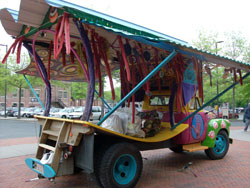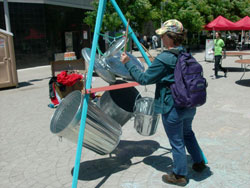Bob Hepner
As artist Krzysztof Wodiczko observed in the CAA Art Journal, “Public Space is where we enact democracy… Public space should be essentially empty… available to anyone who can bring meaning to it.” Yet, he continued, “in reality (public space) is not empty but controlled and barricaded by speakers, commercial and political, who speak at the expense of silent others.” While the recent actions of the Bush administration have made it clear how limited and fragile our civil liberties are in this so called “free” society; commercial and political interests have controlled and limited individual expression even under the best of times in US History.
Any unregulated public expression can expose the limits imposed by these interests.
When I perform my carnival, it uses music, lighting, dance and kinetic movement to invoke different emotional states, publicly. This expression of normally private and circumscribed feeling in the public sphere (in the guise of “play” – dress up, dance, physical interaction with the large sculpture/toys) creates a palpable sense of power and potential among the audience-participants. The sculpture carnival is a spectacle that “enacts democracy,” through the public expression of private emotions.
The truck alters the way people see a common street space that they normally experience uncritically, through private daily interests (shopping for groceries, short errands, walking from point to point). The experience of a spectacle injects an unexpected potential into this daily space. The audience realizes how easy it is to alter their experience of the space. They realize they can take control of it; they realize that they often experience public space and its regulation uncritically. The sculptures themselves are not overtly political, but they mimic strong human emotions (vulnerability, joy, anger, passion). The performance of emotion in the normally bland, controlled public space is a powerful act that makes the audience think critically about the nature of public space in our country. As a performer, I address these issues in informal discussions with the audience.


